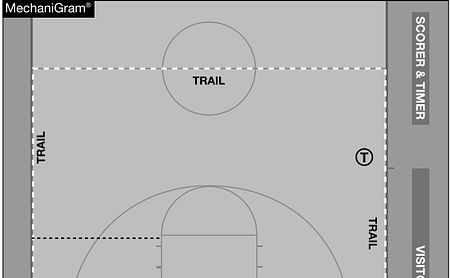This is from the NASO Mechanics Illustrated Book for 2021-2022.

Quote:
Covering boundary lines is among the most difficult tasks using a crew of two officials. By correctly placing so much emphasis on off-ball coverage for the lead, some boundary-line coverage sometimes gets sacrificed.
The NFHS manual states that in the frontcourt the lead is responsible for the sideline nearest the lead and the endline. The trail is responsible for the division line and the sideline nearest the trail. While in theory that sounds easy, the actual practice is very difficult and sacrifices off-ball coverage in the lane area.
Here’s an example. A trouble spot for two-person crews is a player who has the ball near the sideline above the free-throw line extended and opposite the trail. The trail correctly moves toward the center of the court to officiate the action on the player with the ball, such as fouls, traveling violations, etc.
The problem: The manual states that sideline is the lead’s responsibility. Well, if the lead has to look beyond the free-throw line extended to watch for a potential sideline violation and the trail has to watch for fouls, etc., who is watching the other players? No one. There are too many off-ball problems that can occur if no one is supervising those players.
Referee recommends that the trail also have opposite sideline responsibility above the free-throw line extended. Sometimes, the trail must move well beyond the center of the court to see an out-of-bounds violation. Stay deep (toward the division line) on the play to get a good angle.
Even with great hustle toward the far sideline, it is a tough look for the trail. The problem compounds if there’s a swing pass back toward the other sideline. The trail must hustle back toward that sideline to get a good look there. Staying deep gives the trail a chance.
|
If you teach the lead properly and even the trail properly, the lead will widen out their coverage to cover the sideline. Staying close to the lane is not what the lead should do on plays close to the sideline. Is this ideal coverage, but how in the hell does the Trail see a player stepping on the line or a close tip near the sideline (similar to the play featured). I do not like this trend if this is what
Referee is recommending.
Peace